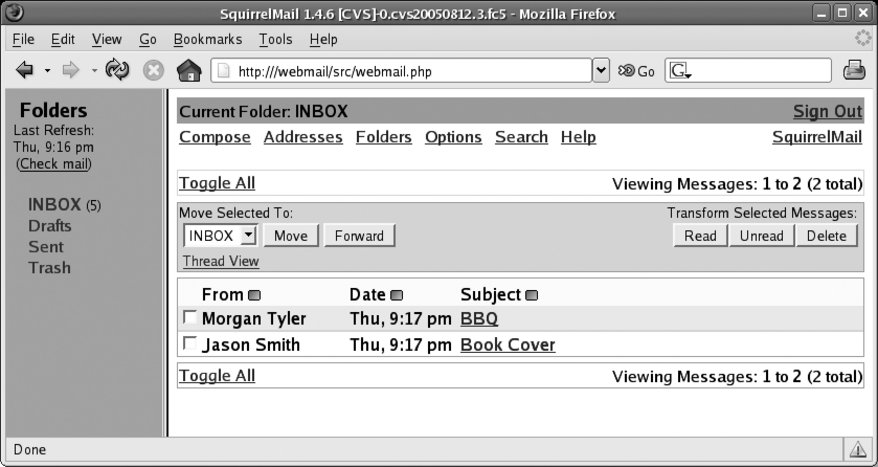Section 7.8. Configuring Webmail
7.8. Configuring WebmailWhen you're on the move, it's nice to have consistent access to your email. If you set up SquirrelMail, you'll be able to access your email from any web browser. 7.8.1. How Do I Do That?Before you set up SquirrelMail, you'll need a working Apache configuration and the Dovecot IMAP server. If you're using SELinux, you must permit web scripts to create network connections. Use the graphical SELinux configuration tool or enter this command: # setsebool -P httpd_can_network_connect 1
You can now use SquirrelMail by accessing https://<hostname>/webmail. The web page shown in Figure 7-21 should appear.
Figure 7-21. SquirrelMail login page Once you enter your user ID and password, the main inbox display will appear, as shown in Figure 7-22. Figure 7-22. SquirrelMail inbox page 7.8.2. How Does It Work?SquirrelMail is a set of PHP scripts that reside in the directory /usr/share/squirrelmail. The file /etc/httpd/conf.d/squirrelmail.conf contains an Alias directive, which aliases that directory to http://<hostname>/webmail. When a user attempts to log in, the PHP scripts contact the local Dovecot IMAP server and tries to log in with the same user ID and password. Because the authentication information is passed directly to the IMAP server, SquirrelMail doesn't need an authentication mechanism of its own. Once connected to the IMAP server, SquirrelMail accesses your mailbox contents, reformats the messages into web pages, and passes them back to Apache for delivery to the browser. SquirrelMail also installs a daily cron job through the file /etc/cron.daily/squirrelmail.cron; this cron job cleans up any temporary files that have been left lying around for more than 10 days. 7.8.3. What About...7.8.3.1. ...changing the SquirrelMail configuration?You can change individual user preferences using the Option link within the SquirrelMail web interface. Global SquirrelMail configuration is performed by running the script /usr/share/squirrelmail/config/conf.pl. You will be greeted with a menu: # /usr/share/squirrelmail/config/conf.pl SquirrelMail Configuration : Read: config.php (1.4.0) --------------------------------------------------------- Main Menu -- 1. Organization Preferences 2. Server Settings 3. Folder Defaults 4. General Options 5. Themes 6. Address Books 7. Message of the Day (MOTD) 8. Plugins 9. Database 10. Languages D. Set pre-defined settings for specific IMAP servers C Turn color off S Save data Q Quit Command >> Type the number or letter of the option you wish to configure; then press Enter and follow the instructions on the screen. For example, to change the default theme: Command >> 5 SquirrelMail Configuration : Read: config.php (1.4.0) --------------------------------------------------------- Themes 1. Change Themes Default Plain Blue Sand Storm Deep Ocean ...(Lines snipped)... Random (Changes every login) Midnight Penguin 2. CSS File : R Return to Main Menu C Turn color off S Save data Q Quit Command >> 1 Define the themes that you wish to use. If you have added a theme of your own, just follow the instructions (?) about how to add them. You can also change the default theme. [theme] command (?=help) > ? .-------------------------. | t (detect themes) | | + (add theme) | | - N (remove theme) | | m N (mark default) | | l (list themes) | | d (done) | \Q-------------------------' [theme] command (?=help) > l * 0. Default (../themes/default_theme.php) 1. Plain Blue (../themes/plain_blue_theme.php) 2. Sand Storm (../themes/sandstorm_theme.php) 3. Deep Ocean (../themes/deepocean_theme.php) 4. Slashdot (../themes/slashdot_theme.php) ...(Lines snipped)... 31. Midnight (../themes/midnight.php) 32. Alien Glow (../themes/alien_glow.php) 33. Dark Green (../themes/dark_green.php) 34. Penguin (../themes/penguin.php) [theme] command (?=help) > m 32 [theme] command (?=help) > d SquirrelMail Configuration : Read: config.php (1.4.0) --------------------------------------------------------- Themes 1. Change Themes Default Plain Blue Sand Storm Deep Ocean ...(Lines snipped)... Random (Changes every login) Midnight Alien Glow Dark Green Penguin 2. CSS File : R Return to Main Menu C Turn color off S Save data Q Quit Command >> s Data saved in config.php Press enter to continue... [Enter] Command >> q Exiting conf.pl. You might want to test your configuration by browsing to http://your-squirrelmail-location/src/configtest.php Happy SquirrelMailing! 7.8.3.2. ...browsers that don't support JavaScript or ECMAScript?SquirrelMail has been designed to work regardless of whether JavaScript is enabled. 7.8.4. Where Can I Learn More?
|
EAN: 2147483647
Pages: 115
